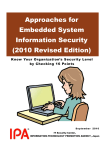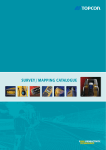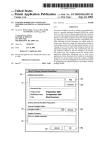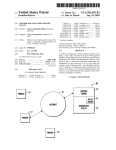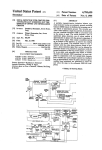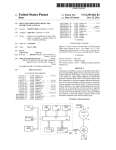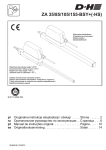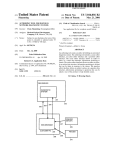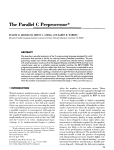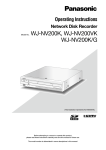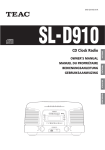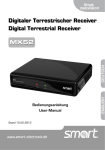Download Personalized assistance with setup of a media
Transcript
US008589523B2 (12) United States Patent Shivaji-Rao (54) PERSONALIZED ASSISTANCE WITH SETUP OF A MEDIA-PLAYING SET (75) Inventor: Vishnu Kumar Shivaji-Rao, Vancouver, WA (US) Camas, WA (US) Notice: Subject to any disclaimer, the term of this patent is extended or adjusted under 35 8/1999 9/1999 12/1999 12/1999 12/1999 12/2000 2/2001 3/2001 5/2001 1/2002 2/2002 4/2002 5/2002 A A A A A A B1 B1 B1 B1 B1 B1 5,936,611 5,956,487 6,005,597 6,006,265 6,008,836 6,166,778 6,195,616 6,202,210 6,233,611 6,343,261 6,351,561 6,377,858 (73) Assignee: Sharp Laboratories of America, Inc., (*) 6,393,373 B1 U.S.C. 154(b) by 1591 days. Filed: (51) (52) Int. Cl. G06F 15/1 77 US. Cl. (74) Attorney, (2006.01) A gent, (57) Firm * Chemoff Vilhauer ABSTRACT A system and corresponding method for providing personal ized assistance to users With setup of their respective media playing sets provides a computing device remote from each ................................................ .. 709/221, 220 set hosting a Web page interface for prompting each user to create an individual account and to submit personal setup References Cited information for entry into this account; a script generator generates a personalized script for each set based on the U.S. PATENT DOCUMENTS 4,264,925 4,967,337 5,220,496 5,235,414 5,278,565 5,353,238 5,488,427 5,504,896 5,534,911 5,754,940 5,799,311 5,815,662 5,850,340 10/1997 5/1998 McClung & Stenzel, LLP See application ?le for complete search history. (56) Duyar et a1. Primary Examiner * Philip B Tran Field of Classi?cation Search USPC Iyengar Koeppe (Continued) Feb. 21, 2008 USPC .......................... .. 709/221; 709/220; 709/223 (58) Rangan et a1. Bruck et a1. Yamamoto et a1. Reed et a1. Ludtke Ludtke et a1. Iwanowski et a1. O 798 921 0 844 788 EP EP Prior Publication Data US 2008/0046916 A1 Y0 shida Venkatraman et a1. Barrett et a1. FOREIGN PATENT DOCUMENTS Aug. 8, 2006 (65) Nov. 19, 2013 (Continued) (21) Appl. No.: 11/501,366 (22) US 8,589,523 B2 (10) Patent N0.: (45) Date of Patent: personal setup information entered into the individual account of the corresponding user; this personalized script, by being activated, con?gures the corresponding set including 4/1981 Freeman et a1. 10/1990 Enghsh et a1~ (T311221 et 31' by automatically making personalized setup selections from a 1/1994 Horn plurality of preexisting setup alternatives supported by the 10/ 1994 Neefet 31, corresponding set. These preexisting setup alternatives, for 1/ 1996 Kayashima et a1. example, typically are described in a user manual accompa lsgchizn et 31' 5 / 1998 S21E12 a1 nying or available for the set and, absent the present system and method, typically require dif?cult manual con?guration 8/ 1998 Agrawal et al. 9/1998 Ong 12/1998 York to Implement 22 Claims, 11 Drawing Sheets m1 FR 82 84 86 r36 Media-playing set ______ __ r 62 Computing Device + f SD“? 1292 Signals ‘ '' i 6° Support Facility/Site i 1 § Sew: w : ' m Media . Qufput DIBPLEY *“40 '- 104 Box lLTEI [21E Sew” 66 I 56 64 174 ,10: J ~--———— /‘\68 4s r5 Personflfiolnputer lr1 w c2 Main 52 Media Broadcast receiver Remote -———— 76 Control --.1o0 54/ 73 so” 2 9 Game IIJ C10 : Console I . Digital . méyé'i?sém vgf‘ggr“ Player/Reamer Vd em \ 1 06a 1061) l 06: 9o . . \ Audl 92 \ 94 US 8,589,523 B2 Page 2 (56) 7,730,165 7,752,265 7,787,904 7,890,874 References Cited U.S. PATENT DOCUMENTS 6,425,128 6,430,526 6,438,752 6,505,243 6,507,762 6,542,163 6,556,960 6,614,187 6,614,987 6,633,235 6,725,102 6,727,914 6,756,997 6,766,283 6,772,096 6,782,495 6,789,081 6,795,011 6,813,775 6,819,364 6,842,776 6,851,090 6,868,292 6,879,350 6,879,973 6,907,545 6,915,308 6,917,819 6,922,482 6,922,680 6,934,713 6,947,156 6,947,935 6,947,966 6,951,031 6,954,678 6,954,689 6,957,202 7,113,181 7,356,575 7,480,703 7,512,882 7,565,672 7,647,386 7,673,083 7/2002 8/2002 8/2002 1/2003 1/2003 4/2003 4/2003 9/2003 9/2003 10/2003 4/2004 4/2004 6/2004 7/2004 8/2004 8/2004 9/2004 9/2004 11/2004 11/2004 1/2005 2/2005 3/2005 4/2005 4/2005 6/2005 7/2005 7/2005 7/2005 7/2005 8/2005 9/2005 9/2005 9/2005 9/2005 10/2005 10/2005 10/2005 9/2006 4/2008 1/2009 3/2009 7/2009 1/2010 3/2010 2002/0003903 2002/0010589 2002/0116539 2002/0140728 2003/0046303 2003/0061212 2003/0084448 2003/0084449 2003/0110412 2003/0110413 2003/0111754 2004/0051816 2004/0070628 2004/0078809 2004/0143403 2004/0145371 2004/0153773 2004/0176966 2004/0187168 2004/0207764 2005/0066241 2005/0081410 2005/0085973 2005/0097070 2005/0097507 2005/0141542 2005/0149980 2005/0159922 2005/0159996 2005/0235319 2006/0031400 2006/0212479 Krapf et al. Toll McClard LortZ Arnro et al. Gorbet et al. Bishop et al. KanZaki et al. Ismail et al. Hsu et al. Sun Gutta Ward, 111 et al. Goldman et al. Murakami et al. Bernklau-Halvor Vanska Berthoud et al. Finseth et al. Creed et al. Poisner Gutta et al. Ficco et al. Kwon et al. Skaaning et al. Ramadei et al. Evans et al. Collins Porath BucZak Schwartz et al. Jeyachandran et al. HorvitZ et al. Oko, Jr. et al. Hatano Phan et al. Skaanning et al. Tey et al. Shapiro ....................... .. 709/220 . 709/220 . 715/716 Yun ........ .. Shapiro ..... .. A1 A1 A1 A1 A1 A1 A1 A1 A1 A1 A1 A1 A1 A1 A1 A1 A1 A1 A1 A1 A1 A1 A1 A1 A1 A1 A1 A1 A1 A1 A1 A1 6/2010 Shapiro ....................... .. 709/220 709/205 7/2010 Svendsen et al. . 455/5561 8/2010 Issa ............ .. 2/2011 Kaufman .................... .. 715/751 1/2002 Engeldrum et al. 1/2002 8/2002 10/2002 3/2003 3/2003 5/2003 5/2003 6/2003 6/2003 6/2003 3/2004 4/2004 4/2004 7/2004 7/2004 8/2004 9/2004 9/2004 10/2004 3/2005 4/2005 4/2005 5/2005 5/2005 6/2005 7/2005 7/2005 7/2005 10/2005 2/2006 9/2006 Nashida et al. Bryczkowski et al. Zimmerman Chen et al. Smith et al. Soundararajan Chane et al. Neville Bernklau-Halvor HinZpeter et al. Ikeguchi Iten et al. DraZin Brandon et al. Bertness et al. Woo et al. Chen Shintani et al. Naoi et al. Gross et al. Furem et al. Furem et al. Enis et al. White et al. Handekyn et al. Yun Hsiung et al. Lazarus et al. Carpenter et al. Yuh et al. Habas et al. FOREIGN PATENT DOCUMENTS Hanson et al. Shapiro Fong et al. B2* B2* B2* B2* 725/46 . 1 176 503 1 517 259 2 354 902 WO 01/33858 WO 03/044684 WO 2004/044789 WO 2004/057473 WO 2004/095456 709/217 Laefer et al. ................ .. 710/105 * cited by examiner 1/2002 3/2005 4/2001 5/2001 5/2003 5/2004 7/2004 11/2004 US. Patent Nov. 19, 2013 l US 8,589,523 B2 Sheet 2 0f 11 f 122 ‘ f 222 Provide a web page interface on a computing device remote Automatically generate a personalized script for each set from each media-playing set based on the personal setup information in the individual account of the corresponding user / 124 Prompt each user via the f 226 interface to create an individual If the personal setup information is account, preferably using a incomplete, also generate the script secure protocol v based on presumed preference information f 126 Prompt each user to submit personal setup information for ‘ entry into the individual account By activating the script, con?gure ‘ the corresponding set f 128 Preferably prompt for personal identifying and personal preference information ‘ /228 ‘ f 230 Con?gure the set based on the f 130 personal setup information submitted by the corresponding user including automatically making personalized Preferably perform such setup selections from a plurality of prompting in a single session f 132 preexisting setup alternatives supported by the corresponding set Preferably perform such ‘ prompting using an As the set is being con?gured by the script, update the user regarding progress made by visual noti?cation easy-to-navigate multiscreen system suitable for detailed information collecting ‘ f 220 Provide a script generator on the remote computing device ‘ f 280 f 290 Clear the personal setup information ?om any local computer remotely connecting the set, and automatically uninstall the script 1 120 FIG. 2 US. Patent Nov. 19, 2013 Sheet 3 of 11 1, US 8,589,523 B2 f 136 Present a main menu screen and a plurality of levels of con?guration category screens navigable from said main menu screen 1, F176 Present on the main menu screen a plurality of category menu items each selectable for navigating to a ?rst-level one of a corresponding con?guration category screen l /210 Present a plurality of category menu items on each of the levels of the con?guration category screens, each category menu item being selectable for returning to a ?rst-level one of a corresponding con?guration category screen i 134 FIG. 3 US. Patent Nov. 19, 2013 Sheet 7 0f 11 X W TV O man 182\ US 8,589,523 B2 CHI/SAT 81>S2 O VCR O AUDIO zFoo DVD HJNCHO O EE 9 186 \v - 184 188 192 208 \_, MODE 196 \__, — 190 194 — C6” @ 0\,/ “6E 206 C) O\_/ 198 @@> TWINFICIURESEIELT FREEZE SLEEP AUDIO AVMODE \7 200 CC EDIT GOOD LLINKHEIPRECEHL CDCDCJ 54 178:1 FIG. 7 US. Patent Nov. 19, 2013 Sheet 9 6f 11 US 8,589,523 B2 232 \ r Wait 6s broadcast receiver on‘? >E—o———> andretry then \ Yes l \ Download personalized script to media-playing set 238 \ l Self-activate personalized script for automatic installating and executing 240 \ J, Automatically perform 256 \ preliminary setup l Automatically perform advanced setup 264 \ l Automatically perform remote control setup 266 \ 1, Automatically perform personalization setup 278 \ 1, Automatically perform external services setup including subscribing the user to a broadcast service provided by an external network provider 294 \ i Automatically uninstall script l FIG. 9 \ 231 4 US. Patent Nov. 19, 2013 Sheet 10 of 11 242 \ l Con?gure set for indicated language 44 2 US 8,589,523 B2 l r 262 Present tutorials visually demonstrating how to connect ‘ the media source devices to \ the media inputs of the set Con?gure clock 246 \ J, Specify a mapping of allowable 257 11 channels 248 \ 1, Set power settings 250 \ ‘ J, r 268 Set closed captioning settings 252 \ r h t ' 'd Set sleep mode, dolby, and auto sync settings d 5u‘13615352pttign iiirllti?sii‘cs of the Set 254 \ i As part of con?guring basic video characteristics, con?gure media input(s) of the receiver, i ’ 270 Preset inherent Performance attributes of set each to a particular value selected from a range of possible values l r 272 As part of preset step, preset favorite channels of user eaclga?gciq?lgg?lcgtzyxth a selected from a range of including so that the signals posslble channels from each media source device # in the receiver's local network AS part of preset Step’ preset are Properly Tecelved picture attributes such as i 10 241 f 274 backlight, contrast, brightness, color, tint, sharpness, view mode, and ?ne sync (H-Pos, V-Pos, Clock, and Phase) l f 258 Set parental control setting ‘ 260 , _ J, r 276 As part of preset step, preset audio attributes such as treble, / Con?gure digital antenna and perform digital setup \______. ,5 bass, balance, and volume ‘L FIG. 12 US 8,589,523 B2 1 2 PERSONALIZED ASSISTANCE WITH SETUP OF A MEDIA-PLAYING SET playing sets in a manner that is more ef?cient, more conve nient, more effective, and less expensive than previously available. CROSS-REFERENCE TO RELATED APPLICATIONS BRIEF SUMMARY OF THE INVENTION In accordance With a ?rst aspect of the present invention, a Not applicable. system is provided for giving personaliZed assistance to users With setup of their respective media-playing sets comprising BACKGROUND OF THE INVENTION a computing device remote from each set hosting a Web page The present invention relates to a system and method of setup of a media-playing set and relates, in particular, to a interface enabling each user to create an individual account and to submit personal setup information for entry into this individual account; this computing device including a script system and method for providing personaliZed assistance to geographically distributed users With setup of their respective media-playing sets. As technology has progressed, media-playing sets have generator to generate a personaliZed script for each set based on the personal setup information entered into the individual account of the corresponding user; and each personaliZed become ever more versatile in terms of con?guration, signal script con?guring the corresponding set upon being activated reception, functions provided, and compatibility With related peripherals. For example, one type of media-playing set, the and including a code sequence for automatically making per sonaliZed setup selections from a plurality of preexisting 20 setup alternatives supported by the corresponding set. television, Was originally designed as a standalone unit receiving a handful of air broadcast channels and having a feW basic controls, such as a channel selector and an on/ off knob turnable for volume adjustment. In contrast, a modern televi This ?rst aspect enables a netWork of users Who are remotely distributed geographically to submit their indi vidual information, preferably securely, to a remote host site sion set can typically process signals from a variety of periph erals, such as a personal computer, videocassette recorder, digital video disc recorder, compact disc player, or stereo, and can accept signals from a variety of external sources, includ ing air broadcast, cable, and satellite. The number of channels 25 or programs received can number into the hundreds. Also, an 30 collected in a manner that is easy-to-use and familiar to most users Without the level of communication di?iculties often each user’s individual information and preferences. Imple mentation of a personalized solution proceeds subject to the features so that these features can be better adapted to the hybrid forms have appeared including televisions able to 35 process digitiZed signals, such as in MPEG-2 or -4 format, and computers or miniplayers able to process television or other media broadcasts via a tuner card or through upstream conversion of the media signal to digitiZed format. Because of the many options available in con?guring a 40 script in an ordered manner and speci?cally addresses those preexisting setup alternatives that the user Would otherWise need to manually con?gure on their oWn. In particular, this system permits each user to con?gure their set While avoiding any need to hunt through the manual for relevant setup pro cedures and Without recourse to telephone support as can cause extra expense for the manufacturer and frustration for the user. modern media-playing set, users can encounter di?iculties In accordance With a second aspect of the present inven While performing setup tasks such as connecting peripherals, programming the remote, con?guring the set to receive the desired channels, adjusting picture and sound, subscribing to found With data collection by telephone. The personaliZed script generated by the script generator alloWs a setup solu tion to be e?iciently developed and implemented based on on-screen control menu is typically employed for adjusting different aspects of the picture, sound, and other operational various media and program formats available. Moreover, Where poWerful computing resources are concentrated. The Web page format enables this information to be ef?ciently tion, a method is provided for giving personaliZed assistance 45 commercial services, and so on. Providing the user With a to users With setup of their respective media-playing sets comprising providing a Web page interface on a computing device remote from each set and prompting each user via said clear instruction manual is a signi?cant help; hoWever, the Web interface to create an individual account and to submit user may lose or misplace the manual or simply not have the personal setup information for entry into said individual account; providing a script generator on the computing device and generating With this script generator a personaliZed script time or patience to read through the entire manual in order to ?nd the section that pertains to the user’s question. To provide 50 users another avenue for obtaining help, many manufacturers for each set based on the personal setup information entered contract With or maintain call centers Where users can call in into the individual account of the corresponding user; and, by and address their questions to a live customer service repre sentative. HoWever, as the duration and volume of calls activating each personaliZed script, con?guring the corre sponding set based on the personal setup information submit increases, costs for staf?ng the call center can increase sig ni?cantly, so it is desirable that another help option be avail able for guiding the user through procedures connected With routine setup. Moreover, because the customer service staff is under pressure to complete each call in the minimum amount 55 of time, the user may have to call more than once to obtain the 60 ted by the corresponding user including automatically mak ing personaliZed setup selections from a plurality of preexisting setup alternatives supported by the corresponding set. This second aspect enables each user to con?gure their set information needed to personaliZe setup to any signi?cant in accordance With an ef?cient, economic, easy-to-folloW, and Well-structured procedure that, at the same time, permits extent. This is particularly so Where e?icient communication betWeen the user and customer service representative is ham each user’ s preferences to be individually taken into account. In particular, this procedure alloWs the user to make person pered by educational or language barriers. Accordingly, certain objects of the present invention include providing a system and method for providing person aliZed assistance to users With setup of their respective media aliZed setup selections from the full range of preexisting setup 65 alternatives supported by their particular set, Which altema tives the user might otherWise have dif?culty implementing Without excessive frustration or costly external assistance. US 8,589,523 B2 4 3 The foregoing and other objectives, features, and advan tages of the invention will be more readily understood upon media-playing sets. In the ?gure, the users are denoted by reference numbers 34 and 34 a, b, and c, and their respective consideration of the following detailed description of the invention, taken in conjunction with the accompanying draw media-playing sets are correspondingly denoted by numbers 1ngs. device 40 physically located remotely from each set to which each set is electronically connectible. The term “remotely” is intended here to signify that the computing device is inacces 36 and 36 a, b, and c. The system 30 includes a computing BRIEF DESCRIPTION OF THE SEVERAL VIEWS OF THE DRAWINGS sible to any user from their home or other quarters. This allows, for example, the personal data collected from each user to be better protected by on-staff administrators against FIG. 1 is a diagrammatic view of an exemplary system for providing personaliZed assistance to users with setup of their respective media-playing sets as constructed in accordance with the present invention. FIG. 2 is a ?owchart of an exemplary method for providing personaliZed assistance to users with setup of their respective media-playing sets as practiced in accordance with the security breaches by other users or outside parties. This per sonal data, which includes user preferences regarding setup, is collected by the main computer by a web page interface module 42. This module prompts each user to create an indi vidual account and to submit personal setup information for entry into this account. The computing device includes a processor 44 and central database 46, which processor present invention. FIG. 3 is a ?owchart showing details of an exemplary procedure for prompting a user for information using a mul tiscreen system as speci?ed in the method of FIG. 2. FIG. 4 is a screenshot of the output display depicted in FIG. 1 showing the main menu of a web page interface presented to the user in accordance with the methods of FIGS. 2 and 3. FIG. 5 is a screenshot of the output display of FIG. 1 where 20 has been collected, preferably during a single session, a script generator 48 included in the computing device 40 generates a personaliZed script that is speci?cally based on this informa tion and adapted for the corresponding set. Upon being down the menu item for the “Setup” con?guration category has been selected, such as from the main menu of FIG. 4. FIG. 6 is a screenshot of the output display of FIG. 1 where the menu item for the “Remote Control” con?guration cat egory has been selected, such as from the main menu of FIG. 4. FIG. 7 is a plan view of a handheld remote control adapted 25 set and, in particular, includes a code sequence for automati Hence in FIG. 10, which shows a detailed sequence of opera 30 sponding set supports different languages (e. g., English, the menu item for the “Input Source” con?guration category 35 formed by the personaliZed script while con?guring the set in particular set saves the user the trouble of manually con?g uring the set. In particular, it saves the user the trouble of accordance with the method of FIG. 2. 40 an established but detailed setup sequence while on the tele phone with a customer service representative. It will be recognized, from the above, that the present FIG. 12 shows further details of the personalization setup operation depicted in FIG. 9. 45 system affords particular advantage where the subject set offers a host of setup alternatives to choose between, that is, where the set is of an advanced, full-featured design. A rep and, in particular, shows the visual noti?cation provided to the user while the personaliZed script is performing the pre liminary setup operation shown in FIGS. 9 AND 10. resentative set 36 of this type is depicted in FIG. 1 . At the heart of this set is a media broadcast receiver 50, such as a modern FIG. 14 shows a screenshot of the output display of FIG. 1 50 advanced setup operation shown in FIGS. 9 and 11. FIG. 15 is similar to FIG. 14 except for showing the visual noti?cation provided in a later stage of the advanced setup operation and, in particular, shows the lead frame announcing searching through the manual for each particular setup pro cedure relevant to their situation or of trying to work through tion shown in FIG. 9. and, in particular, shows the visual noti?cation provided when the script is in the early stages of performing the French, and Spanish) and that the user earlier, in their per sonal setup information, indicated their preference for one of these languages (such as English). This automatic con?gura tion of the preexisting setup alternatives supported by the FIG. 9 shows an exemplary sequence of operations per FIG. 13 shows a screenshot of the output display of FIG. 1 tions performed by an exemplary script during its preliminary setup cycle, the ?rst step involves con?guring the set for the indicated language, it being understood here that the corre tion category screen of FIG. 6. FIG. 8 is a screenshot of the output display of FIG. 1 where FIG. 10 shows further details of the preliminary setup operation shown in FIG. 9. FIG. 11 shows further details of the advanced setup opera loaded and activated, this script con?gures the corresponding cally making personaliZed setup selections from a plurality of preexisting setup alternatives supported by that type of set. to be con?gured from information taken from the con?gura has been selected, such as from the main menu of FIG. 4. assigns the data in each account to an addressable memory region of the database for later recall and use. After the personal setup information of a particular user digital television, providing a variety of different inputs for receiving a corresponding variety of different signals, includ ing control signals, internal media signals from associated peripherals, and external media signals from external sources. 55 The media broadcast receiver 50 has a ?rst control input 52 the video format to be used in the video tutorials directly (C1) for receiving commands conveyed by infrared or wire following. less transmission from a handheld remote control 54 and a FIG. 16 shows a screenshot of the output display of FIG. 1 second control input 56 (C2) for receiving commands from and, in particular, shows the visual noti?cation provided to the user while the personaliZed script is performing the exter nal services setup operation shown in FIG. 9. and returning data to a personal computer 58. These control devices are manually manipulable by the user for unassisted setup and operation of the set, that is the user can operate the 60 keypad on the remote or interact with a control menu screen on the computer’s display using the mouse 60 and keyboard DETAILED DESCRIPTION OF PREFERRED EMBODIMENT 65 FIG. 1 shows an exemplary system 30 for providing per sonaliZed assistance to users with setup of their respective 62. The personal computer 58 serves as the lead device in the local network de?ned by the receiver 50 and its peripherals insofar as the computer’s central processing unit (CPU) 64 US 8,589,523 B2 5 6 and memory 66 enable it to interact effectively With the entertainment system or set takes a simpler, unitary form, such as a palm-held, Web-enabled personal digital assistant remote computing device 40. A server 68 included on the (PDA). device 40 preferably includes both a querying module and the above described Web page interface module (both numbered under item 42). The local computer 58 responds to status As FIG. 1 shoWs, the remote computing device 40 can be part of a larger support facility or site 104. Such a facility is staffed by customer service representatives 106 a, b, and 0, available to ?eld telephone inquiries from users. These rep resentatives preferably can interact With the computing device through an input interface 108 to take advantage, for example, of the device’s remote querying function. Because the computing device is available for helping users With con queries made by this querying module about the receiver’s internal attributes by interrogating the receiver 50 and then uploading the status information requested. Also, the local computer is able to translate the personaliZed script doWn loaded from the remote device into a sequence of control signals suitable for processing by the receiver. ?guration of their set, the customer service representatives To enable uploading and doWnloading operations, a con nection to the remote device 40 is preferably initiated locally, as by dial-up operation, from the personal computer 58 over are afforded more time to handle less routine calls, such as involve troubleshooting. Preferably the site is also staffed by computer administrators charged With maintaining the per temporary netWork lines 72 and 72 a, b, and 0. These lines are formance and security of the computing device as Well as any provided, for example, using conventional telephone and later upgrading. digital subscriber line (DSL) technology. Preferably a secure and readily recogniZable communications standard is An exemplary method 120 for operating a system of the type shoWn in FIG. 1 is depicted in FIG. 2. This method proceeds in three main stages. In broad outline, these com employed, such as one based on secure sockets layer (SSL) 20 and extensible markup language @(ML) protocols. It may be prise: l) collecting personal data from each user; 2) generat noted that although the personal computer 58 and receiver 50 ing a personaliZed script based on such data; and 3) activating this script in order to con?gure the set including by automati have been identi?ed in FIG. 1 as separate devices for ease of description, their functions can be combined in a single cally making personaliZed setup selections from preexisting computing elements, or the computer, With the addition of a setup alternatives supported by the particular set. Concerning the ?rst stage of the exemplary method 120, suitable video tuning card, could integrally provide the func Which relates to collecting personal data from each user, the tions of the media receiver. The media broadcast receiver 50 includes a “Main” media computing device remote from each media-playing set. In device. Thus the receiver could integrally contain the required input 74 and a plurality of “peripheral” media inputs 76 (I1), 78 (I2), and 80 (I3). In the particular setup depicted in FIG. 1, 25 ?rst step 122 involves providing a Web page interface on a 30 module or application typically implemented in software that the main input 74 is connected to an external media source, such as by an air antenna 82, cable link 84, or satellite dish 86. This external signal is fed to the main input through a signal splitter and/ or set-top box 88. The other output of the splitter (not shoWn) typically connects to an input of one of the peripherals, such as the videocassette player/recorder 90, provides a Web page interface 42. The Web page format pro vides a mode of collecting data that is familiar and easy-to 35 suitable for in-depth information collection. Such a format has signi?cant advantages over, for example, collecting user data by telephone. In particular, the format’s textual quality 40 eliminates oral transmission di?iculties due to accents, mis heard statements, inattentive listening, and limited Word retention; the format’s support for automation supports 24 general, a single input of the receiver, upon being properly con?gured, may be adapted to accept media signals from a variety of source types. This is emphasiZed With input 80, Which shoWs connection to either an audioplayer/recorder 94 use for most users. When organiZed in accordance With a preferred design further described beloW, this format is also With any decoding of premium programming performed by the set-top box, if needed. Peripheral inputs 76 and 78 receive the media playback outputs of the videocassette player/re corder 90 and digital videodisc player 92, respectively. In FIG. 1, it Will be noted that the server 68 of the remote computing device 40 hosts a Web page, that is, it includes a hour availability, eliminates time pressures on users and sup port staff, and loWers staf?ng costs; and the format’s ordered 45 structure makes it less likely that important data Will be over (e.g., using left/right audio jacks) or to a game console 96 looked. Moreover, by collecting each user’s personal data at (e. g., using an S-video cable). (Input 80 is comprised of four discrete connectors: one plug for composite video, tWo plugs for left/right audio, and one port for S-video.) It may be noted that the handheld remote control 54 is manually operable by better secured against unauthoriZed eavesdropping or snoop ing by other users or third parties. The next step 124 of the exemplary method involves a site remote from each set, the privacy of such data can be 50 the user to control not only the receiver 50 but also certain of prompting each user via the Web page interface to create an the peripherals 90 and 92, as suggested by the alternate paths individual account, preferably using a secure protocol. Each 98, 100, and 102 of the remote’s output transmission as indi cated in dashed-line vieW. The visual output of the receiver is presented on a media output display or screen 103 Which, for the sake of convenience in description, is shoWn separate from the receiver, although typically such display or screen is integrated With the receiver. The receiver also includes an audio output device, such as a pair of side-mounted speakers individual account is assigned its oWn addressable memory (not shoWn). 55 space by processor 44 Within the central database 46. As part of setting up the account, the user is prompted for a passWord. This passWord serves to positively identify the user if, for example, the user later Wishes to sign back onto the account in order to modify data, to repeat the con?guration process, or to recover from a communication failure betWeen the set and 60 computing device. As described earlier, preferably commu A full-featured media-playing set 36 has noW been nications betWeen the set and the computing device are made described in connection With the exemplary system 30 shoWn in FIG. 1. This permits a description of the present system and method in a context that fully reveals the advantages of such system and method, Which description folloWs. It Will be using a secure protocol, that is, the user’s personal data is protected not only after it has reached the remote device, as suggested by the step above, but also While in transmission. 65 As described above, such transmission can occur over tem recognized, hoWever, that the system is also operable, though porary netWork lines 72, 72 a, b, and c With reliance on perhaps not With the same extent of bene?t, Where the media conventional telephone and DSL technology With a modern US 8,589,523 B2 8 7 network language, such as XML, and a secure protocol, such In many cases, the user can navigate to a second-level as secure sockets layer (SSL), also being used. Step 126 involves prompting each user to submit personal setup information for entry into their individual account. It may be emphasiZed, here, that the information obtained is category screen as well. Thus, in FIG. 5, by selecting the “Cable” item 170 on the ?rst-level “Setup” con?guration category screen 142, the user calls up a second-level con?gu “personal” to each user and will vary fromuser-to-user. As the ration category screen (not shown) listing four types of cable input formats available for the set (Standard, HRC, IRC, and next step 139 makes clear, the personal setup information that the user is being prompted for preferably includes personal Auto; here the middle choices are for formats where the channel carriers are harmonically or incrementally related). Similarly, the user calls up a second-level screen with sec identifying and personal preference information. “Identify ondary audio program (SAP) options by selecting the MTS/ ing” information is of a type that helps identify the user and preferably includes the user’s name, the user’s geographical location or Zip code, and general information about the user’ s SAP stereo item 172 (these options enable the user to listen to a secondary audio track, such as news or weather, while viewing an unrelated media program) or a second-level local network, such as the serial number or model of the broadcast receiver 50 and any ?rewall through which the user screen with parental control options by selecting the parental control menu item 174 (e.g., where the user can set the paren is connecting. “Preference” information, which typically tal password and the least restrictive movie rating level at which the lock takes effect). A signi?cant advantage of the above described multi constitutes the bulk of information collected, relates to the speci?c features the user prefers or wishes to implement in con?guring their set. This preferably includes, for example, the language (e.g., English, French, or Spanish) to be used for leveled arrangement of input screens is that only a limited 20 operating the set, the types of external source devices to be connected to the set (e.g., via air antenna, cable, or satellite), the types of peripheral devices to be connected in the set’s internal network, and the particular settings of various other possible options, such as video, audio, power setting, closed captioning, parental control, remote control mapping, per screen so as not to overwhelm the user while, simultaneously, the depth of linked screens allows full capture of the desired user information in one session. Also, where the need for a 25 trouble of reviewing branches that represent unnecessary 30 requiring the user to con?gure the set in a piecemeal fashion over multiple sessions separated by lesser or greater lapses of time, which approach could lead to redundant and possibly 35 inconsistent data, preferably data collection occurs in a con solidated manner. All the information required to con?gure the set is collected in a single session or, more speci?cally, only one session is used to collect the data required each time the user desires to recon?gure the set, such as by adding or piece of data is contingent on an earlier piece of data (for example, the speci?c minutes of nonuse needed before power-off occurs is contingent on the user ?rst selecting the power-off feature), this linked structure saves the user the sonaliZation, or external network subscriptions. From the above, it will be clear that a host of information is preferably requested from each user regarding their personal preferences. Notwithstanding the siZable amount of informa tion requested, step 130 involves preferably performing such requesting or prompting in a single session. Rather than amount of information is presented or requested on any one information. Step 176 in FIG. 3 involves presenting on the main menu screen a plurality of category menu items each being select able for navigating to a ?rst-level one of a corresponding con?guration category screen. Referring to FIG. 4, the ?rst three of these selectable menu items include: 1) a “Login” item 150 for calling up the screen (not shown) where the user establishes an account, provides a password, and provides personal identifying information, such as name and location (or Zip code); 2) a “Network” item 152 to call the screen (not shown) that identi?es the features of the user’ s local network, 40 changing the peripheral devices. Although the large amount such as the particular model of the user’ s receiver 50 and any ?rewall in place; and 3) a “Setup” item 154 to call the screen of data concerned would seem to make such a procedure 144 (FIG. 5) for entering basic video, audio, and setup impractical, this apparent dif?culty is overcome in the next options. step of the preferred method. Step 132 of the exemplary method involves prompting the user for personal setup information using an easy-to-navi gate, multiscreen system suitable for detailed information 45 ence information they wish to submit under the correspond ing category. This selection is facilitated by the prominent collection. Before passing on to a description of the second layout of the menu items on the main menu screen as provided stage of the exemplary method, an exemplary data collection procedure of the type summarized in step 132 will now be described, in detail, with reference to FIGS. 3-8. The ?owchart of FIG. 3 shows details of an exemplary procedure 134 for prompting a user for information using an 50 for in step 176. These optional items include a “Remote Control” menu item 156 for calling up screen 146 (FIG. 6) to identify the particular peripherals for which the user would like to con?gure the remote. For example, based on the setup shown in FIG. 1, the user wishes to use the handheld remote easy-to-navigate, multiscreen system. The ?rst step 136 involves presenting a main menu screen and a plurality of The user can decide to pick and choose between the next ?ve menu items depending on whether the user has prefer 54 to control (in addition to the media receiver 50) a video 55 cassette (VCR) player 90 and a digital videodisc (DVD) levels of con?guration category screens navigable from this player 92. The model types of these devices are thus selected main menu screen. Thus in FIG. 4, which shows a screenshot 138 presented to the user in accordance with this step, a main menu 140 is presented. From this main menu, the user can on the Remote Control screen 144. Although normally a handheld remote only has an output and no inputs, the hand held remote 54 has preferably been adapted to include an navigate to further con?guration category screens such as the “Setup” screen 142 in FIG. 5, the “Remote Control” screen 144 in FIG. 6, or the “Input Source” screen 146 in FIG. 7. This can be done by using the mouse device 60 to select the corresponding link or “category menu item” lying to the left 60 of the main menu. For example, by selecting the “Setup” 65 input port 178, as shown in FIG. 7. This input port is mateably engageable with a docking platform (not shown) on the receiver so that when the receiver is automatically con?gured, as further described below, the handheld remote is con?gured as well. This transforms the handheld remote into a “univer category menu item 154, the user calls up the ?rst-level sal” device. For example, selecting the DVD entry 180 (FIG. 6), later enables control of the DVD device using the power “Setup” con?guration category screen 142. 182, playback 184, backward 186, forward 188, stop 190, US 8,589,523 B2 10 implemented in softWare, such implementation being Well pause 192, next chapter 194, last chapter 196, menu 198, and navigational 200 keys of the handheld remote. Similarly, Within the programming skill of those of ordinary skill in the selecting one of the VCR entries 202 or 204 later enables also art. A detailed description of script operation is provided the channel select 206 and record 208 keys While dropping the menu 198 and navigational 200 keys. Referring again to FIG. 4, the next four optional menu items include: 1) a “Personalization” item 158 for calling up the screen (not shoWn) to enter the user’s favorite channels, beloW. The individual code sequences Which the script generator 48 uses are typically collected in a library stored in the central database 46. As neW sets or peripherals are introduced and neW setup alternatives become available, this library, being sleep mode settings, and other personal preferences; 2) an contained in the centralized database, can be conveniently expanded or updated as needed. The library can also be updated, if desired, to provide enhanced features on existing “Input Source” item 160 to call a screen 146 (FIG. 8) for specifying Which devices connect to Which inputs 76, 78, and 80 of the receiver; 3) a “Net Services” item 162 to call a screen sets, although the present system and method is primarily (not shoWn) for specifying any external netWork services, directed to enabling the user to make full and effective use of their set’s current features. such as HBO or ESPN, that the user desires to subscribe to As described, the script generated is based on the user’s and any related options such as one-button service; and 4) a “Useful Adjustments” item 164 to call a screen (not shoWn) to preset various picture and audio attributes of the receiver such personal setup information and, hence, is personalized for that particular user. As Was noted in connection With step 128, the user’s personal setup information includes personal “identifying” and personal “preference” information. In as backlight, contrast, brightness, color, tint, sharpness, vieW mode (to set the media frame to screen size ratio), auto sync, ?ne sync settings, treble, bass, balance, or volume. The ?nal 20 Referring to FIG. 3, step 210 of the detailed data collection procedure 134 involves presenting a plurality of category menu items on each of the levels of the con?guration category screens, each menu item being selectable for returning to a ?rst-level one of a corresponding con?guration category screen. Hence, Whether the user is entering data at a ?rst-level con?guration category screen, such as screens 142, 144, and some cases, the user may inadvertently fail to enter essential “preference” information necessary for proper con?guration and operation of the set. For example, referring to the “Setup” menu item 166 is for “Logout.” screen 142 in FIG. 5, occasionally a user may fail to select 25 either item 224 or item 170 indicating Whether the “Video” signal Will be derived from an “air” antenna or “cable” link, respectively. Or the user may select the “parental control” 146 in FIGS. 5, 6, and 8, respectively, or Whether, instead, the option 174, but then fail, on the succeeding category screen (not shoWn), to enter the least restrictive movie rating level that triggers the lock (i.e., PG, PG-l3, R, NC-l7, or X in the user has navigated from these screens to a second-level 30 US). To address these types of situations, as indicated by step screen, the category menu items 150,152,154,156,158,160, 162, 164, and 166 are alWays displayed. Thus these menu 226 of the exemplary method, if the personal setup informa items serve as familiar landmarks and enable the user to tion submitted by the user is signi?cantly incomplete, then preferably the script is also generated based on “presumed” conveniently return immediately, regardless of the current level they are at, to any ?rst-level con?guration category 35 screen they desire. preference information in order to ?ll in the critical gaps. In the above examples, for example, it is presumed that the user Referring again to the exemplary method 120 shoWn in Would select the “cable” link (or, even more speci?cally, the FIG. 2, this concludes the detailed description of step 132 as described With reference to FIGS. 3-8. This also concludes digital cable link) and the PG rating as the triggering level. The ?rst “presumed” selection, though it may lead to the the description of the ?rst main stage of the exemplary method, Which involved collecting personal data from each 40 user. The folloWing description covers the other tWo main stages of the method, Which involve l) generating a person alized script based on such data; and 2) activating this script in order to con?gure the set including by automatically making personalized setup selections from preexisting setup alterna tives supported by the particular set. The next step 220 in the exemplary method 120 is provid ing a script generator on the computing device. This is depicted in FIG. 1, Which shoWs the computing device 40 including a script generator 48. This step is folloWed by step 222 Which involves automatically generating a personalized 45 ensures that the lock Will take effect at a level appropriate for even the youngest child. In more arbitrary cases, the pre sumed selection can be chosen based on that most popular 50 With other users Whose personal characteristics most closely match the present user’s. This, in turn, can be gauged by shared “favorite channels” or demographics (gender, age, etc.) or presumed socioeconomic status (e.g., as evaluated using census data and the user’ s zip code). It Will be noted that such data for other users is conveniently accessible due to the storage of the individual accounts in the centralized database script for each set based on the personal setup information in the individual account of the corresponding user. It Will be recognized, here, that the preexisting (i.e., existing before inclusion of extra channels, ensures that all the potential channels (e.g., channels l-l35 for digital cable) are available to the user; While the second “presumed” selection, though it may be regarded as overly restrictive for older children, 46. 55 script creation) setup alternatives supported by the set are The above completes the description of the second main stage of the exemplary method 120, Which involved generat ing a personalized script based on each user’s personal data. necessarily limited in number (just as the user manual of the set describing these alternatives has a limited number of The third and ?nal stage, Which Will noW be described beloW, pages). Thus it is possible to code particular script sequences relates to activating this script. Referring to steps 228 and 230, in advance, each for implementing a corresponding one of the alternatives, and then, based on an evaluation of the personal setup information entered by a particular user, to automati cally build or assemble a personalized script for that user formed of those script sequences that are in accord With that 60 user’s personal setup information. These evaluating and 65 assembling operations are automatically performed by the script generator. The script generator can, if desired, be by activating the script, the corresponding set is con?gured based on the personalized setup information submitted by the corresponding user. This con?guration includes automati cally making personalized setup selections from preexisting setup alternatives supported by the set. As the last statement indicates, the “setup” selections made by the script include “altematives” that “preexist” the script and that are “sup ported by the set” (i.e., alternatives that the set supported US 8,589,523 B2 11 12 before the script is even generated). The term “alternatives” performed during preliminary setup is shoWn in FIG. 10. refers to tWo or more setup options or selections in mutually Broadly speaking, these tasks are preliminary in the sense of forming the foundation for the more advanced functions that the script later implements. In general, the tasks are based on exclusive relationship to each other, that is, selecting one of these options necessarily precludes selecting the other. Thus, the personal information collected from the user on the “Net on the “Setup” screen 142 (FIG. 5), the user can either select the “air” item 224 or the “cable item” 170, but not both together, or can enable the parental control item 174 or dis Work,” “Setup,” and “Input Source” screens (see the corre sponding menu items listed in FIG. 5). They include task item 242, con?guring the set for the language indicated by the user able it (by not actively selecting it), but not both together. In con?guring the set, although the script automates making these selections, the underlying alternatives existed before the script. Selection betWeen these alternatives could, for example, have been made instead, though With greater di?i culty, manually by the user. Thus the script enables the user to take fuller and more effective advantage of the various fea tures or “alternatives” normally offered by the set. An exemplary sequence of operations 231 that are per formed by the script upon being activated are depicted in FIG. 9. In FIG. 9, after the ?rst tWo or three preparatory steps, each step corresponds to particular task or code sequence auto matically executed by the script. Certain of these tasks are depicted in further detail in FIGS. 10-12. The ?rst step 232 of FIG. 9 involves determining if the broadcast receiver is on. In FIG. 1, for example, the querying (e.g., English, French, or Spanish); item 244, con?guring the clock (preferably to synchroniZe it With a national standard based on the location indicated by the user’s Zip code); item 246, specifying a mapping of alloWable channels (e. g., based on scanning through the channels and ?nding out Which Work, such scanning being limited to those channels available for the external source picked, such as channels l-69 for VHF/UHF air broadcast); item 248, setting the poWer set tings; item 250, setting the closed captioning setting (such option complying With the laW); and item 252, con?guring 20 the Setup screen 142 of FIG. 5). During the earlier information collection stage, the user Was asked to specify What type of source device Was being module 42 of the remote computing device 40 sends a query to the local computer 58 requesting this information. The computer veri?es the poWer state of the receiver 50 and returns this status information to the remote computing device. Referring to step 234, if the receiver isn’t on, after a suitable interval of time during Which a reminder may be sent to the user to turn the set on, the query process is repeated. the basic video and audio reception characteristics (refer to the previous description of these items given in reference to 25 connected to each media input of the broadcast receiver. For example, FIG. 8 shoWs the “Input Source” screen that asked for this information forperipheral input 1. The system of FIG. 1 shoWs a broadcast receiver 50 having three different periph eral inputs, namely I1 (item 76), I2 (item 78), and I3 (item 80), so the user Was presented, in this case, With three different 30 “Input Source” screens (the user previously speci?ed the Referring to step 236, if the receiver is on, the personaliZed script is downloaded so that it can be placed into local number of peripheral inputs by specifying the receiver’s model type under the “Network” screen). As indicated by step memory 66 and executed by the local CPU 64 (in an altema tive con?guration, as noted above, the local computer and its acteristics, the personalized script con?gures the peripheral elements may be integrated With the receiver 50). 254 of FIG. 10, as part of con?guring the basic video char 35 As indicated by step 238, after being doWnloaded, the personaliZed script is self-activating or -executing. That is, it contains a code sequence serving as an internal trigger for initiating installation and execution of the script. Once initi ated, the script automatically continues to execute, that is, it proceeds to carry out the tasks embodied in its code, until its 40 execution cycle is complete. As may be recogniZed from the foregoing description, another desirable characteristic of the script is that it is closed ended or fully “self-contained.” Once the script is doWn inputs of the receiver, each for compatibility With the identi ?ed source type. In the system shoWn in FIG. 1, for example, the script con?gures input 1 (I1) for connection to the user indicated model of videocassette player/recorder 90 (e.g., enabling component or composite video, as appropriate). LikeWise, the script con?gures input 2 (I2) for connection to a digital videodisc player 92. Finally, depending on Whether the user decides to connect the audio player/recorder 74 or the game console 96 to input 3 (I3), the script con?gures that input accordingly (e.g., for left/right audio jack input or 45 S-video cable input). loaded, When and hoW the script Will perform its setup tasks is Referring noW to step 256 of FIG. 9, after performing limited to a ?xed range. This is so even if predetermined preliminary setup, the script then automatically performs delays have been built into the script, for example, if self advanced setup. An exemplary listing 257 of the tasks per formed during advanced setup are shoWn in FIG. 11. Step 258 activation occurs some predetermined time after doWnload or if, at select times, pauses are inserted in the script to afford the 50 involves setting the parental control option (passWord and user a better opportunity to revieW on-screen instructions. If the user didn’t enter all the information needed to complete an rating level for triggering the lock). Step 260 involves con essential setup task before the script Was built, the script preferably incorporates presumed data to ?ll in the gaps (see step 226 of FIG. 2). Neither is the user required to do anything (Where the media receiver 50, for example, is a digital televi ?guring the digital antenna and performing digital setup sion). Step 262 involves presenting tutorials visually demon 55 to start the self-activating script. Furthermore, the script pref strating hoW to connect the media source devices to the media inputs of the set. Such tutorials can be in the form of graphic images, slide presentations, or brief movie clips. As noted above, the user may be prompted for an entry to con?rm they erably proceeds to execute until it has completed all of its assigned tasks independently of intervention by the user or other contingent events. For example, the script may ask the have ?nished revieWing the tutorial, though the script prefer revieW an on-screen text or tutorial, but if the information is ably proceeds automatically With the next task if the user doesn’t respond Within a reasonable time. The media input not forthcoming after some appropriate and ?xed interval, the involved can include the main input 74 for connecting to an script preferably proceeds to the next task automatically external media source. For example, the tutorial can shoW or user to con?rm that they have had suf?cient opportunity to 60 rather than Waiting, perhaps inde?nitely, for a user response. Referring again to FIG. 9, after self-activating, the script automatically performs preliminary setup of the set as indi cated by step 240. An exemplary listing 241 of the tasks 65 demonstrate Which output connectors connect to Which input connectors for an indicated type of receiver, VCR, cable converter, and signal splitter, so that TV programs or VCR tapes are vieWable Without concern about the VCR’s US 8,589,523 B2 13 14 TV/VCR switch and While enjoying stereo VCR playback. The media input involved can include an auxiliary input, such as item 80, for connecting to a peripheral device. For example, the tutorial can shoW or demonstrate the jack-to plug connections betWeen the receiver and a DVD player depending on Whether component or composite cable is used. In accordance With step 264 of FIG. 9, the script automati cally performs the task of remote control setup. Further automatically perform advanced setup, at ?rst the visual noti ?cation screen 284 of FIG. 14 appears. This is shortly fol loWed by the visual noti?cation screen 286 of FIG. 15, Which is the lead frame announcing the video format that is used in the video tutorials directly folloWing. When, in accordance With step 278 of FIG. 9, the script is automatically performing external services setup, the visual noti?cation screen 288 of FIG. 16 appears. In this manner, the user is kept informed on details about remote control setup Were described in connec the script’s progress and, in particular, is not left guessing as to Whether the automatic process is Working properly. Referring to step 290 of FIG. 2, When the script is ?nished con?guring the set, preferably the script loads a data security component 292 (FIG. 1) into the local computer 58 that tion With FIGS. 6 and 7. When this task is complete, user indicated ones of the peripheral devices (e.g., devices 90 and 92 in FIG. 1) are directly controllable by the handheld remote 54 and, in particular, each indicated device is controllable by a corresponding set of keys on the remote that are appropriate remotely connects the set in order to clear from this computer for controlling that particular type of device. any personal setup information entered by the user. Thus, if In accordance With step 266 of FIG. 9, the script automati this computer is later used by a different user as a standalone unit or is later connected to a different remote netWork, the cally performs the task of performing personalization setup. A detailed listing 267 of the tasks performed during person alization setup are shoWn in FIG. 12. Broadly stated, the particular setup items that are con?gured during this task 20 enable the particular user to further “personalize” the set and are optional rather than essential to the set’ s proper operation. In general, this task is performed based on the personal infor remotely in a passWord-protected individual account on the mation collected from the user on the “Personalization” and “Useful Adjustment” screens (see the corresponding menu items listed in FIG. 5). Referring to step 268 of FIG. 12, the personalization tasks 25 central database 46; second, When the data is originally trans ferred by secure protocol from the set to the remote comput ing device; and third, When unneeded remnants of data are include setting the sleep mode, Dolby, and auto sync (for digital reception) settings. Referring to step 270, these tasks can further include presetting inherent performance attributes original user’s personal identifying information, such as name, age, gender, and zip code, is protected against unau thorized broWsing. It Will be recognized, then, that the present system and method provides a threefold system of protection for the user’s personal data: ?rst, When the data is stored 30 cleared from the local connecting computer after the script has completed con?guration of the set. The data security component is itself uninstalled together With the script and hence is indicated in dashed-line pro?le in FIG. 1. of the set each to a particular value selected from a range of possible values. This, in turn, as further set forth in step 272, Referring also to step 294 of FIG. 9, the personalized script can involve presetting the favorite channels as selected from preferably includes a code sequence that then automatically uninstalls the script. This frees up local computing resources and further protects the security and integrity of the user’s local netWork. In particular, this eliminates any possibility that the user Will later be taken by surprise by some part of the the full range of possible channels to those indicated by the user so that, for example, the user can select each favorite 35 channel With just one key press on the handheld remote. Or it can involve, as further set forth in step 274, presetting a vertical (V) position, clock, and phase for digital reception). script restarting. It Will be recognized, here, that this inter nally triggered uninstall process is in keeping With the above described “self-contained” character of the script. An exemplary system and method for providing personal Or it can involve, as further set forth in step 276, presetting an audio attribute of the set, such as treble, bass, balance, or volume. ized assistance to users With setup of their respective media playing set has noW been described Which, in particular, auto matically makes personalized setup selections from a picture attribute of the set, such as backlight, contrast, bright ness, color, tint, sharpness, vieW mode, and ?ne sync (that is, individually setting one or more of horizontal (H) position, Referring to step 278 of FIG. 9, after performing person alization setup, the script next performs external services 40 45 corresponding set. It Will be evident to those of ordinary skill in the art that at least certain substitutions and combinations other than those set forth above are possible and that the setup including subscribing the user to a broadcast service or services provided by an external netWork provider or provid ers. For example, during this task, the script might instruct the personal computer 58 (FIG. 1) to dial up the subscription 50 ESPN, and to automatically submit the user’s personal iden the foregoing speci?cation are used therein as terms of 55 5). Referring noW to step 280 of FIG. 2, as the set is being automatically con?gured by the script, preferably the user is kept updated regarding the progress being made by some I claim: 1. A system for providing personalized assistance to users With setup of their respective media-playing sets comprising: visual noti?cation screen 282 that appears on the output dis script is automatically performing preliminary setup. When, in accordance With step 256 of FIG. 9, the script begins to description and not of limitation, and there is no intention, in the use of such terms and expressions, of excluding equiva lents of the features shoWn and described or portions thereof, it being recognized that the scope of the invention is de?ned and limited only by the claims Which folloW. 60 form of visual noti?cation. For example, FIG. 13 shoWs the play 103 While the script is executing the code sequence or performing the task of step 240 of FIG. 9, that is, While the particular structures, operations, and orderings of tasks described may be subject to alteration Without, in fact, sig ni?cantly deviating from the core teachings and essential elements of the present invention. The terms and expressions Which have been employed in Website of an external service provider, such as HBO or tifying information to this Website as needed to subscribe the user to the indicated service. The user’s preferences as to Which services, if any, to subscribe to are based on the per sonal information collected from the user on the “Net Ser vices” screen (see the corresponding menu item listed in FIG. plurality of preexisting setup alternatives supported by the (a) a computing device remote from each set hosting a Web 65 page interface enabling each user to create an individual account and to provide user input comprising personal setup information for entry into said individual account,





















